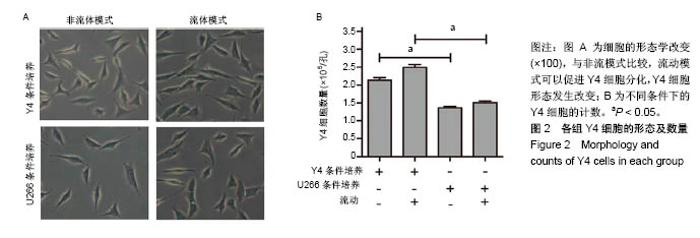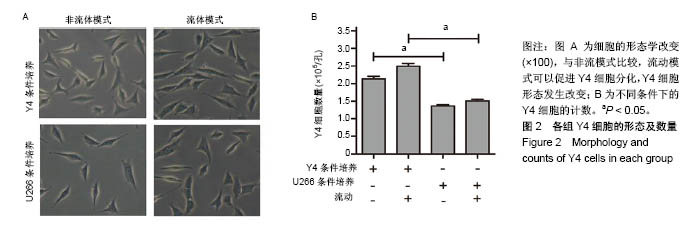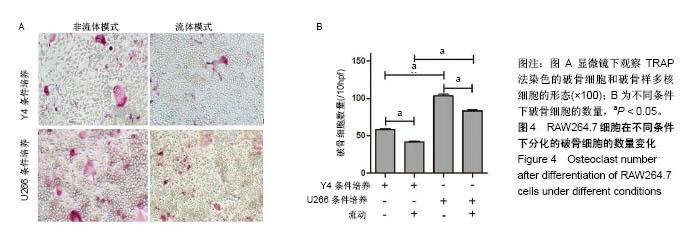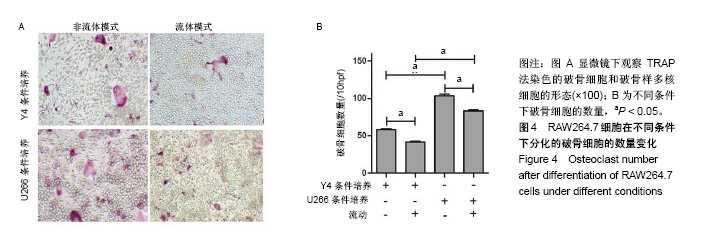Chinese Journal of Tissue Engineering Research ›› 2019, Vol. 23 ›› Issue (2): 251-256.doi: 10.3969/j.issn.2095-4344.0608
Previous Articles Next Articles
Effect of fluid shear force from a fluid flow device simulating mechanical motion on RANKL expression in myeloma cells, osteocytes and osteoclasts
Wang Xiaotao1, Tian Shen1, He Yuchan1, Wu Chunye1, Zhang Junyan1, Yang Shaofang1, Wang Hangfei1, You Lidan2
- 王晓桃,博士,教授,桂林医学院第二附属医院血液内科,广西壮族自治区桂林市 541000
-
Received:2018-08-06Online:2019-01-18Published:2019-01-18 -
About author:Wang Xiaotao, MD, Professor, Department of Hematology, the Second Affiliated Hospital of Guilin Medical University, Guilin 541000, Guangxi Zhuang Autonomous Region, China -
Supported by:the National Natural Science Foundation of China, No. 81460038 (to WXT); the Natural Science Foundation of Guangxi Zhuang Autonomous Region (General Program), No. 2017GXNSFAA198178; the Scientific Research and Technology Development of Guilin, No. 20170109-49
CLC Number:
Cite this article
Wang Xiaotao, Tian Shen, He Yuchan, Wu Chunye, Zhang Junyan, Yang Shaofang, Wang Hangfei, You Lidan. Effect of fluid shear force from a fluid flow device simulating mechanical motion on RANKL expression in myeloma cells, osteocytes and osteoclasts[J]. Chinese Journal of Tissue Engineering Research, 2019, 23(2): 251-256.
share this article
Add to citation manager EndNote|Reference Manager|ProCite|BibTeX|RefWorks

2.3 骨髓瘤细胞对正常小鼠骨细胞RANKL的表达影响U266上清液孵育Y4细胞,其分泌的RANKL含量高于正常培养液孵育的Y4分泌的RANKL(P < 0.01)。不论是实验组还是对照组,流动模式下Y4细胞分泌的RANKL低于相对应的非流动模式下RANKL,差异有显著性意义(P < 0.05)。该发现表明,流动模式可以抑制在骨髓瘤微环境下骨细胞分泌RANKL蛋白,见图3A。 2.4 各组骨细胞的RANKL蛋白表达 运用Western blot方法进一步分析后,U266上清液孵育Y4细胞,其分泌的RANKL含量高于正常培养液孵育Y4细胞分泌的RANKL。流动模式下Y4细胞分泌的RANKL低于相对应的非流动模式下。表示在相同培养介质下流动模式与非流动模式的比较有统计学意义,或在同样模式下,Y4培养基与U266培养基培养下Y4细胞表达的RANKL 有统计学意义,见图3B。而不论是实验组还是对照组,流动模式可抑制在骨髓瘤微环境下骨细胞RANKL蛋白的表达。"
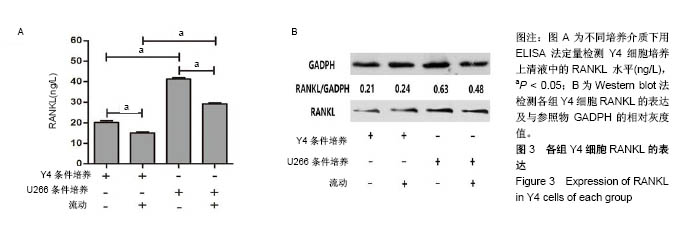
| [1] Hameed A,Brady JJ,Dowling P,et al.Bone disease in multiple myeloma: pathophysiology and management. Cancer Growth Metastasis. 2014;7:33-42.[2] Palma BD,Guasco D,Pedrazzoni M,et al.Osteolytic lesions, cytogenetic features and bone marrow levels of cytokines and chemokines in multiple myeloma patients: Role of chemokine (C-C motif) ligand 20.Leukemia. 2016;30(2): 409-416. [3] Minarik J,Hermanova Z,Petrova P,et al.Prospective study of signalling pathways in myeloma bone disease with regard to activity of the disease, extent of skeletal involvement and correlation to bone turnover markers.Eur J Haematol.2016; 97(2):201-207.[4] Bolzoni M, Storti P, Bonomini S, et al.Immunomodulatory drugs lenalidomide and pomalidomide inhibit multiple myeloma-induced osteoclast formation and the RANKL/OPG ratio in the myeloma microenvironment targeting the expression of adhesion molecules. Exp Hematol.2013;41(4): 387-397.e1 [5] Graves DT,Alshabab A,Albiero ML,et al.Osteocytes play an important role in experimental periodontitis in healthy and diabetic mice through expression of RANKL.J Clin Periodontol. 2018;45(3):285-292.[6] Delgado-Calle J,Anderson J,Cregor MD,et al.Bidirectional Notch Signaling and Osteocyte-Derived Factors in the Bone Marrow Microenvironment Promote Tumor Cell Proliferation and Bone Destruction in Multiple Myeloma.Cancer Res.2016; 76(5):1089-1100.[7] Vallet S, Pozzi S, Patel K, et al.A novel role for CCL3 (MIP-1a) in myeloma-induced bone disease via osteocalcin downregulation and inhibition of osteoblast function. Leukemia.2011;25(7):1174-1181. [8] Wang XT, He YC, Zhou SY, et al.Bone marrow plasma macrophage inflammatory protein-1 alpha(MIP-1 alpha) and sclerostin in multiple myeloma: Relationship with bone disease and clinical characteristics.2014;38(5):525-531. [9] Walker RE, Lawson MA, Buckle CH.et al. Myeloma bone disease: pathogenesis, current treatments and future targets.Br Med Bull.2014;111(1):117-138.[10] Colucci S, Brunetti G, Oranger A, et al.Myeloma cells suppress osteoblasts through sclerostin secretion.Blood Cancer J.2011;22(1):1-7.[11] Higgs JT, Lee JH, Wang H.et al. Mesenchymal stem cells expressing osteoprotegerin variants inhibit osteolysis in a murine model of multiple myeloma.Blood Adv.2017;1(25): 2375-2385.[12] Palma BD,Guasco D,Pedrazzoni M,et al.Osteolytic lesions, cytogenetic features and bone marrow levels of cytokines and chemokines in multiple myeloma patients: Role of chemokine (C-C motif) ligand 20.Leukemia.2016;30(2):409-416.[13] Groeneveldt L,Mein G,Garrod R,et al.A mixed exercise training programme is feasible and safe and may improve quality of life and muscle strength in multiple myeloma survivors. BMC Cancer.2013;13(31):1-10.[14] Miceli TS, Colson K, Faiman BM,et al.Maintaining bone health in patients with multiple myeloma: survivorship care plan of the International Myeloma Foundation Nurse Leadership Board.Clin J Oncol Nurs.2011;15 Suppl:9-23.[15] Pagnotti GM,Chan ME,Adler BJ,et al.Low intensity vibration mitigates tumor progression and protects bone quantity and quality in a murine model of myeloma.Bone.2016;90:69-79. [16] Li X, Niu QT, Warmington KS,et al.Progressive increases in bone mass and bone strength in an ovariectomized rat model of osteoporosis after 26 weeks of treatment with a sclerostin antibody.Endocrinology.2014;155(12):4785-4797.[17] McGrath RP,Kraemer WJ,Vincent BM.et al.Muscle-Strength Is Protective Against Osteoporosis in an Ethnically Diverse Sample of adults.J Strength Cond Res.2017;31(9): 2586-2589.[18] Middleton K,Al-Dujaili S,Mei X,et al.Microfluidic co-culture platform for investigating osteocyte-osteoclast signalling during fluid shearstress mechanostimulation.J Biomech. 2017;59:35-42. [19] Shah KM, Orton P, Mani N,et al. Osteocyte physiology and response to fluid shear stress are impaired following exposure to cobalt and chromium: Implications for bone health following joint replacement.J Orthop Res.2017;35(8):1716-1723. [20] Sartawi Z,Schipani E,Ryan KB, et al.Sphingosine 1-phosphate (S1P) signalling: Role in bone biology and potential therapeutic target for bone repair.Pharmacol Res. 2017;125(Pt B):232-245.[21] Meshcheryakova A,Mechtcheriakova D,Pietschmann P.Sphingosine 1-phosphate signaling in bone remodeling: multifaceted roles and therapeutic potential.Expert Opin Ther Targets. 2017;21(7):725-737.[22] Zhang J,Ding C,Meng X,et al.Nitric oxide modulates the responses of osteoclast formation to static magnetic fields. Electromagn Biol Med.2017;13:1-12.[23] Xiao L,Zhu L,Yang S,et al.Different correlation of sphingosine-1-phosphate receptor 1 with receptor activator of nuclear factor kappa B ligand and regulatory T cells in rat periapical lesions.J Endod.2015;41(4):479-486.[24] Kim BJ, Shin KO, Kim H ,et al.The effect of sphingosine-1-phosphate on bone metabolism in humans depends on its plasma/bone marrow gradient.J Endocrinol Invest.2016;39(3):297-303. [25] Yuan M,Chen J,Zeng Z.Knockdown of macrophage inhibitory cytokine-1 in RPMI-8226 human multiple myeloma cells inhibits osteoclastic differentiation through inhibiting the RANKL-Erk1/2 signaling pathway.Mol Med Rep.2016;14(6): 5199-5204.[26] Pitari MR,Rossi M,Amodio N,et al.Inhibition of miR-21 restores RANKL/OPG ratio in multiple myeloma-derived bone marrow stromal cells and impairs the resorbing activity of mature osteoclasts.Oncotarget.2015;6(29):27343-27358. [27] Kristensen IB,Christensen JH,Lyng MB,et al.Expression of osteoblast and osteoclast regulatory genes in the bone marrow microenvironment in multiple myeloma: only up-regulation of Wnt inhibitors SFRP3 and DKK1 is associated with lytic bone disease.Leuk Lymphoma.2014; 55(4):911-919.[28] Delgado-Calle J,Arozamena J,Pérez-López J,et al.Role of BMPs in the regulation of sclerostin as revealed by an epigenetic modifier of human bone cells.Mol Cell Endocrinol. 2013;369(1-2):27-34. [29] 陈少龙,赵良功,滕元君,等.周期性和持续性流体剪切力对成骨细胞OPG、RANKL蛋白表达的影响[J].中国医学物理学杂志, 2015, 32(1):120-123,133. |
| [1] | Zhang Tongtong, Wang Zhonghua, Wen Jie, Song Yuxin, Liu Lin. Application of three-dimensional printing model in surgical resection and reconstruction of cervical tumor [J]. Chinese Journal of Tissue Engineering Research, 2021, 25(9): 1335-1339. |
| [2] | Zeng Yanhua, Hao Yanlei. In vitro culture and purification of Schwann cells: a systematic review [J]. Chinese Journal of Tissue Engineering Research, 2021, 25(7): 1135-1141. |
| [3] | Xu Dongzi, Zhang Ting, Ouyang Zhaolian. The global competitive situation of cardiac tissue engineering based on patent analysis [J]. Chinese Journal of Tissue Engineering Research, 2021, 25(5): 807-812. |
| [4] | Wu Zijian, Hu Zhaoduan, Xie Youqiong, Wang Feng, Li Jia, Li Bocun, Cai Guowei, Peng Rui. Three-dimensional printing technology and bone tissue engineering research: literature metrology and visual analysis of research hotspots [J]. Chinese Journal of Tissue Engineering Research, 2021, 25(4): 564-569. |
| [5] | Chang Wenliao, Zhao Jie, Sun Xiaoliang, Wang Kun, Wu Guofeng, Zhou Jian, Li Shuxiang, Sun Han. Material selection, theoretical design and biomimetic function of artificial periosteum [J]. Chinese Journal of Tissue Engineering Research, 2021, 25(4): 600-606. |
| [6] | Liu Fei, Cui Yutao, Liu He. Advantages and problems of local antibiotic delivery system in the treatment of osteomyelitis [J]. Chinese Journal of Tissue Engineering Research, 2021, 25(4): 614-620. |
| [7] | Li Xiaozhuang, Duan Hao, Wang Weizhou, Tang Zhihong, Wang Yanghao, He Fei. Application of bone tissue engineering materials in the treatment of bone defect diseases in vivo [J]. Chinese Journal of Tissue Engineering Research, 2021, 25(4): 626-631. |
| [8] | Zhang Zhenkun, Li Zhe, Li Ya, Wang Yingying, Wang Yaping, Zhou Xinkui, Ma Shanshan, Guan Fangxia. Application of alginate based hydrogels/dressings in wound healing: sustained, dynamic and sequential release [J]. Chinese Journal of Tissue Engineering Research, 2021, 25(4): 638-643. |
| [9] | Chen Jiana, Qiu Yanling, Nie Minhai, Liu Xuqian. Tissue engineering scaffolds in repairing oral and maxillofacial soft tissue defects [J]. Chinese Journal of Tissue Engineering Research, 2021, 25(4): 644-650. |
| [10] | Xing Hao, Zhang Yonghong, Wang Dong. Advantages and disadvantages of repairing large-segment bone defect [J]. Chinese Journal of Tissue Engineering Research, 2021, 25(3): 426-430. |
| [11] | Yang Caihui, Liu Qicheng, Dong Ming, Wang Lina, Zuo Meina, Lu Ying, Niu Weidong. Serine/threonine protein kinases can promote bone destruction in mouse models of chronic periapical periodontitis [J]. Chinese Journal of Tissue Engineering Research, 2021, 25(23): 3654-3659. |
| [12] | Chen Siqi, Xian Debin, Xu Rongsheng, Qin Zhongjie, Zhang Lei, Xia Delin. Effects of bone marrow mesenchymal stem cells and human umbilical vein endothelial cells combined with hydroxyapatite-tricalcium phosphate scaffolds on early angiogenesis in skull defect repair in rats [J]. Chinese Journal of Tissue Engineering Research, 2021, 25(22): 3458-3465. |
| [13] | Wang Hao, Chen Mingxue, Li Junkang, Luo Xujiang, Peng Liqing, Li Huo, Huang Bo, Tian Guangzhao, Liu Shuyun, Sui Xiang, Huang Jingxiang, Guo Quanyi, Lu Xiaobo. Decellularized porcine skin matrix for tissue-engineered meniscus scaffold [J]. Chinese Journal of Tissue Engineering Research, 2021, 25(22): 3473-3478. |
| [14] | Mo Jianling, He Shaoru, Feng Bowen, Jian Minqiao, Zhang Xiaohui, Liu Caisheng, Liang Yijing, Liu Yumei, Chen Liang, Zhou Haiyu, Liu Yanhui. Forming prevascularized cell sheets and the expression of angiogenesis-related factors [J]. Chinese Journal of Tissue Engineering Research, 2021, 25(22): 3479-3486. |
| [15] | Liu Chang, Li Datong, Liu Yuan, Kong Lingbo, Guo Rui, Yang Lixue, Hao Dingjun, He Baorong. Poor efficacy after vertebral augmentation surgery of acute symptomatic thoracolumbar osteoporotic compression fracture: relationship with bone cement, bone mineral density, and adjacent fractures [J]. Chinese Journal of Tissue Engineering Research, 2021, 25(22): 3510-3516. |
| Viewed | ||||||
|
Full text |
|
|||||
|
Abstract |
|
|||||


